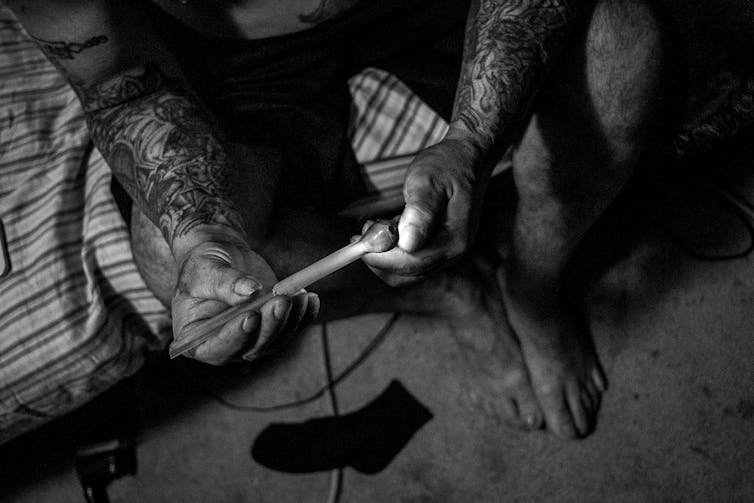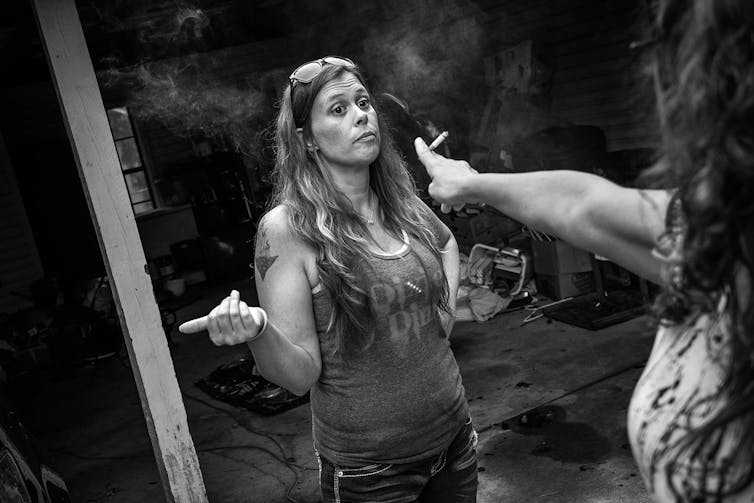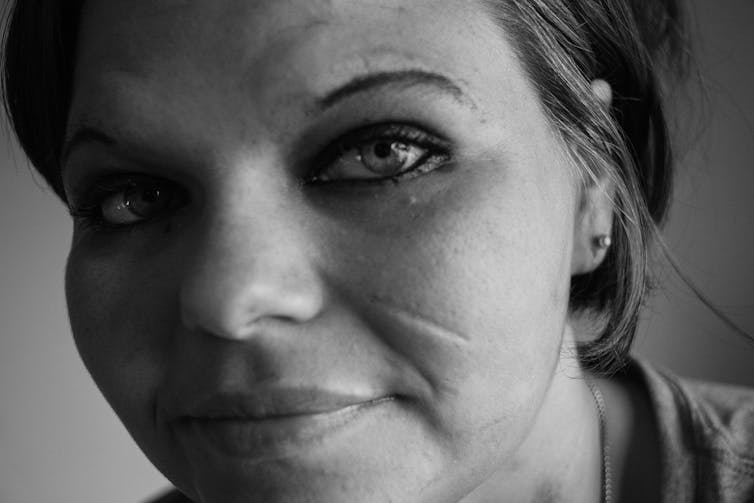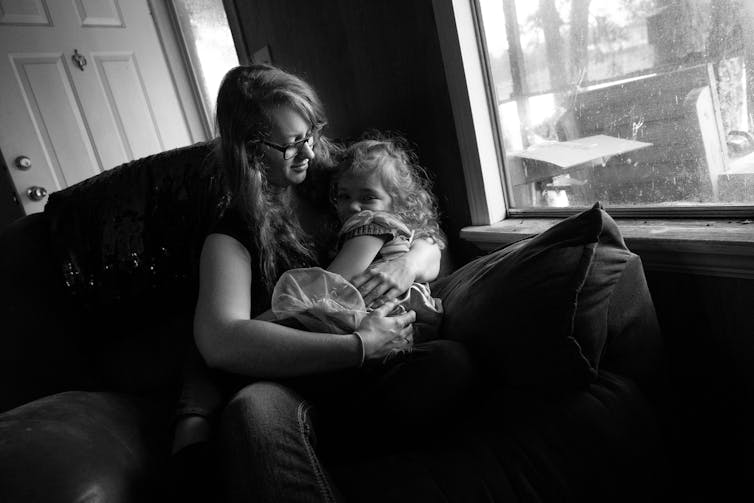
One night, after five days of smoking meth, Misty* heard a voice.
It just said ‘BOOM! Get up’ and I got up and was like, ‘where’s my son?’ and I run to the bathroom and my little girl’s standing at the sink and I could see the water running and coming down the hallway and he was already blue at the bottom of the tub. So I grabbed him up and was like, I mean, panic – I couldn’t do nothing but sing ‘Amazing Grace.’ It’s the only thing I knew to do.
Misty’s son, one of her five children, survived – he was saved by a neighbour who worked for the ambulance service in their Alabama community.
At first glance, Misty’s story is a cautionary tale against drug use, not unlike those portrayed in campaigns like the Faces of Meth and the Meth Project in the US. Media depictions of people who use meth often show reductive, one-dimensional perspectives that demonise people as little more than monsters, criminals and addicts.
While the damaging effects of methamphetamine use are too often true and indeed tragic, as researchers we wanted to understand the greater nuance and complexities of those who used meth. We were particularly interested in the motivations for meth use and the notable gendered differences associated with it, and how those differences can contribute to harm and to gender inequality.

This article is part of Conversation Insights
The Insights team generates long-form journalism derived from interdisciplinary research. The team is working with academics from different backgrounds who have been engaged in projects aimed at tackling societal and scientific challenges.
Misty was one of the 52 people we interviewed over 18 months in the south-eastern US state of Alabama. We developed close relationships with a dozen of them, and ultimately published our findings in the journal Criminology. Central to our research was the role of images, particularly documentary-style photographs made with and by our participants. This was instrumental in helping us connect with them. It was a shared experience that allowed us all to be more comfortable with each other, and made it easier for them to share their stories. The collaborative process of making photographs with participants, showing them our photographs, and having them share theirs with us meant that the photos became intimately connected to data collection.
An epidemic of meth use
Rural America is suffering from an epidemic of meth use, accounting for thousands of drug overdoses every year. Almost 80% of people who use meth in these areas say they have used within the past month. Many of these people are women. Their stories are not just stories of addiction, but of motherhood, resilience and navigating abuse from their partners, much of which was closely linked to meth use.
We heard stories about how meth’s supposed sexual benefits exacerbated domestic abuse and coercive control. Men used violence and control to dictate when, where and with whom their romantic partners used meth, fearing the women would be unfaithful to them. Many sought to isolate, intimidate, manipulate, exploit and degrade their partners so that they could more easily control them.
Although men and women shared some similar motives for using meth, such as boosted energy and experiencing the high, there was significant divergence in how they spoke about the association between sex and meth.
As Chico, one of the male participants, explained:
It’s about sex, sex, sex! It’s a sex drug, plain and simple … Anybody does it and says it don’t make them horny, they lying. … That’s what it’s designed for, to trick your brain to release more dopamine than it normally would and it floods it. That’s your pleasure to your brain. That’s what methamphetamine’s for. You should try it!

But the women we spoke to were less likely than men to say that meth increased their desire for sex. Even among those who said that sex was enhanced while on meth, none said this was their primary motivation for using. In fact, several said that meth diminished their desire for sex and inhibited some men from being able to perform. When we mentioned that the women seldom discussed the benefits of meth for sex, some men rejected these accounts. They countered by saying that women were not being forthcoming because they did not want others to think of them as being promiscuous.
It is probably no surprise that men and women talk about the sexual benefits of meth use differently. Social expectations that women be modest about their sexuality persist among all segments of society, but are especially prevalent in the American South. What was particularly interesting is how men’s stories about meth being a “sex drug” affected how they interacted with women, specifically their romantic partners.

Coercive control
For the men who saw meth as primarily a sex drug, coercive control took various forms. Some women spoke of domestic abuse from their partners, ranging from threats to physical and sexual assaults. Several women said that their partners did not like them interacting with other men. Others spoke of how they tried to avoid falling victim to violence by carefully self-monitoring their behaviour:
I have to be careful of the way I speak to men because they can take the tiniest smile or look the wrong way.
Persistently being on guard so as to not upset or anger their partners was emotionally taxing for the women. Such guarded behaviour denied them the freedom to comfortably be themselves and highlighted how far men’s control extended. Indeed, women watched how they spoke and with whom they interacted even when the men were not with them.
Other men exerted control by insisting that their partners use meth with them. As one woman explained:
I was afraid of getting beat up. It was more of the fear of, if I didn’t do what he says then something bad gonna happen to me or something to the kids … It was like he did not want to do it without me doing it … it was not an option for him. I had to do it when he did, if I didn’t it could get bad.
It was common for the men to try to dictate the amount and frequency with which women used meth. The men believed that by policing meth use they could better protect their women from succumbing to the harmful effects of it, including mitigating the chances that women would be unfaithful. For other men, this meant encouraging their partners to use more meth to facilitate dependence, both on the drug and on their partners to supply it.

Misty: meth, control and motherhood
Misty was introduced to meth by a boyfriend of her sister, who was dealing drugs. He decided he wouldn’t let Misty’s sister have any meth unless Misty also agreed to use. Misty assumed he did this in the hope she would have sex with him, and his coercion worked. Misty believed she could take a hit and be done. Instead, she found herself smoking for five days straight until she finally crashed, leading to the incident where her son nearly drowned.
When we met up with her early in the project, she was married to JC. He would frequently go on binges and disappear from home for days, sometimes weeks, at a time. JC eventually told us that he began using meth to cope with trauma from childhood, when he was sexually abused by a family friend.
[Meth] blocks my memories and emotions out so I feel no pain, I feel no fear. I don’t think about it, it blocks it out.

It was clear that meth played a role in the instability of Misty and JC’s life together. She worried about him – wondering where he was and calling jails to look for him. But according to Misty’s account, he was abusive and controlling to her. He also used meth as a means of coercive control, not allowing Misty to get high with him: “It’s harder for me to not do it then it is for her, she’s good at not doing it.”
On one occasion, JC was in jail, we texted Misty to ask how they were doing. Her reply was heartbreaking – she told us that JC had assaulted her. But this was still not enough for her to leave him. In fact, she said she violated restraining orders to visit JC in jail – an act that could have led to her own arrest. Misty viewed herself as a “ride or die” wife, often excusing and forgiving JC’s controlling and abusive behaviour.
I know when he’s not high and when he’s not on drugs, he’s a good person. And if I can get that person out and get him off drugs, we’d have the best marriage ever.
It was ultimately Misty’s role as a mother that helped her leave JC and give up meth completely. The impetus came when she saw that JC’s abuse was clearly affecting her youngest son, Michael.
What made me really, really leave JC – well, my son looked me in my face and told me: ‘One thing that’s gonna kill you is you gonna die by JC’s hands.’ I had to get out. He saved me. He’s my little hero.
Misty now has a steady boyfriend, a full-time job, her own home and an improved relationship with her children.
Alice
Alice also began using meth due to pressure from a man – her then-boyfriend, Ryan. When we met, Alice was 21 and using meth daily. In our first interactions she was detached, quiet and reserved, often staying in a back room of the trailer to minimise interactions with us or anyone else who might come into the home. Eventually, she came to trust us and shared her plans for the future. More than anything, Alice wanted to regain custody of her daughter.
Alice married young and had a daughter soon after graduating high school. Her marriage was short-lived – she said her husband had been unfaithful, leaving her for someone she considered a good friend. For much of Alice’s life, men had not played stable, caring roles. She believed that her father cared more about her brother than he did about her. Her romantic relationships throughout high school were abusive and characterised by infidelity.
She was sexually assaulted by a friend of the family, but said her mother did not believe her when she spoke about it. After her divorce, Alice was left struggling with feelings of abandonment. To combat this struggle, she began looking for excitement, and she found it in a new relationship with Ryan.

Ryan had a youthful, dangerous charisma. He was a regular user of spice (synthetic cannabinoids) and meth. Although she resisted using for a while, Ryan was persistent and manipulative. Several months into their relationship, he made Alice an offer. He would quit meth but with a symbolic gesture: his last time would be her first time. The plan was that after they used together, they would break the pipe together, and then neither use again. But as Alice said: “We never broke that pipe.”
Their meth use steadily increased. Alice betrayed family members so often they no longer let her stay with them, or even come into their house. She and Ryan ended up staying with Chico at his mobile home. Nearly twice their age, Chico had used, manufactured and sold meth for more than two decades. His trap house – where drugs are sold – was known across the county. It was at Chico’s that Alice’s meth use led to her being ostracised by her family and losing custody of her daughter.

She and Ryan were out on their own, describing themselves as a modern-day Bonnie and Clyde. But once Ryan was arrested for passing counterfeit money, Alice had nowhere to go except Chico’s.
Chico and Alice’s relationship was complicated. Whereas Ryan tried to control her drug use by not letting her use on her own and controlling how much she used, Chico pushed drugs on to her. She began using with needles and her meth use increased substantially. She believes that Chico would shoot her up while she was sleeping to get her further addicted and to coerce sex from her.
After Ryan’s release from jail, he and Alice made a go at staying free from meth. They found a trailer to share with another couple and their newborn baby. But the allure of meth was too strong, and they both began using again. One night while using, Ryan demanded to know what happened between Alice and Chico. She sent us a selfie she made during their argument. The picture featured a dark, featureless silhouette.
This is at the hotel when Ryan had brought up all the Chico stuff, everything came out, because he finally wanted to know everything. I told him that I didn’t want to tell him because I knew he was going to really blow things out of proportion, and when he gets mad he’s got a mouth on him and doesn’t care who hears it and we were at a hotel. He started using a bunch of colourful names and not so nice things. … In the picture I am in the dark, where I felt like I belonged.
Ryan struggled with the fact that Alice had shared a needle with Chico. To him it was a bond that she should have had with him, not Chico. Eventually, Ryan and Alice split up. After bouncing between several homes and relationships – a common occurrence for those who chronically use meth – Alice eventually found a place to stay that provided her with the stability she needed to get a job and begin the process of regaining custody of her daughter. Alice is now over three years free of meth. More importantly, she has a steady job, a place of her own and full custody of her daughter.
“The only thing that really bothers me is when I think about what it felt like to get high, and I miss it,” Alice told us. “And then I’m like, no, it’s not worth it. It took me a long time to get back to being who I am, and I’m a mom.”

The stories and narratives we tell do more than simply relay the past. They can also shape behaviour and relationships. Whether it is narratives of coercion and control like those attributed to Chico and JC, or of redemption and recovery experienced by Misty and Alice, these stories reflect powerful cultural expectations and gender norms, and guide behaviour like drug use and abuse.
It is through analysing these stories that we can understand the complexities and nuanced natures of marginalised people and communities.
*All names have been changed.

For you: more from our Insights series:
The magic of touch: how deafblind people taught us to ‘see’ the world differently during COVID
Liverpool’s unsung COVID heroes: how the city’s arts scene became a life support network
To hear about new Insights articles, join the hundreds of thousands of people who value The Conversation’s evidence-based news. Subscribe to our newsletter.
Les auteurs ne travaillent pas, ne conseillent pas, ne possèdent pas de parts, ne reçoivent pas de fonds d'une organisation qui pourrait tirer profit de cet article, et n'ont déclaré aucune autre affiliation que leur organisme de recherche.
This article was originally published on The Conversation. Read the original article.







